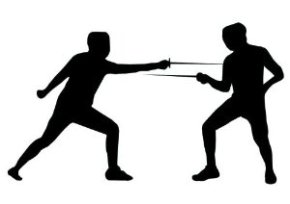Shadow fencing can be an incredibly helpful drill if done properly. It also happens to be one of my personal favorites.
The practice is taken directly from shadowboxing and it works the same way. [Click here for a parallel guide to shadowboxing. The idea behind the drill is strikingly similar between the two sports]
All you need is some open space at your fencing gym. An empty strip is ideal but you want an area that is at least half of that distance. I find that headphones are particularly helpful for blocking out outside distractions.
The fencer moves up and down the strip, essentially fencing by himself. The trick is to visualize the opponent and respond to imagined situations.
It is an excellent way to practice executing your technique and coordination by making yourself go through the technical motions while focusing on the exact execution of the move and how it feels. If you repeat the same motions over and over again, you can build the movements into automatic responses (much like you do in a lesson) and develop the muscles involved for increased speed and power. By using shadow fencing properly you can take what you work on in a lesson and experiment with how to apply it to a real bout situation.
Shadow fencing is also the perfect forum to focus on developing a rhythm for how you move across the strip. In this context you can really focus on the timing of how you move. Does your footwork feel smooth? Are you able to transfer your weight quickly to transition from a preparation to a finishing movement? Are you accelerating fast enough? Is your movement consistently falling into a predictable pattern? Are you staying in the same spot on the strip? All of these are great questions to ask yourself while you move to help you improve your understanding of the tempos for executing an action that are right for different situations.
Much like real fencing, you get the best return from shadow fencing if you go into it with a more nuanced mental approach rather than pure repetition and introspection. This is where the shadow comes into play. In this case, you are competing against your imagination. Who is your opponent? What are they trying to do to hit you? Are they trying to draw out your attack? Are they trying to set up an attack of their own? Are they over extending themselves? Are they accidentally leaving you a small opening? How patient are they being?
You have to juggle your own thoughts and strategy with your imaginary opponent’s strategy. You will get better at this with practice but if you want to make things a little easier on yourself, assign your opponent a single strategy at a time and focus on imagining that specific situation only. Now you can work on executing your physical actions within the imagined context and replay certain situations over and over again. Since the opponent is doing X, what do you need to do to create the opening you are looking for? Do you need to be more patient? More aggressive with the preparation? Experienced fencers will frequently be able to instinctively feel where they are making mistakes, when the action or mentally contrived situation just doesn’t feel right. Correct yourself and keep working. If possible it’s great to have your coach sit and watch. Sometimes they will pick up on subtle technical adjustments for the actions you are working on and help you correct them.
I find that it helps to have an explicit plan of the actions and situations you want to work on in your shadow fencing session before you start. These can be as broadly or narrowly defined as you would like. Write them down if you have to and then spend a few minutes focusing on each. It also helps to set specific time intervals you want to work on each for.
I would also recommend at least using your glove and weapon when you shadow fence. This will help you think about and drill the coordination between your blade and your footwork, which is crucial in a real bout.
The number of situations you can create for yourself is only limited by your imagination and the contrived context can be a much more interesting and rewarding way to do footwork. No other drill gives you the ability to repeat and calibrate so many different key mental and physical aspects of how you move.
The variety of benefits and customizable approaches that can be applied for each individual make shadow fencing one of my favorite fencing drills ever.
Click here to like Jonathan’s Facebook Page , Jonathan Yergler (athlete), and here to follow his Twitter handle @yerglerj.

Pingback: Watch and Learn – How to use Videos to Elevate Your Game – Fencing Videos